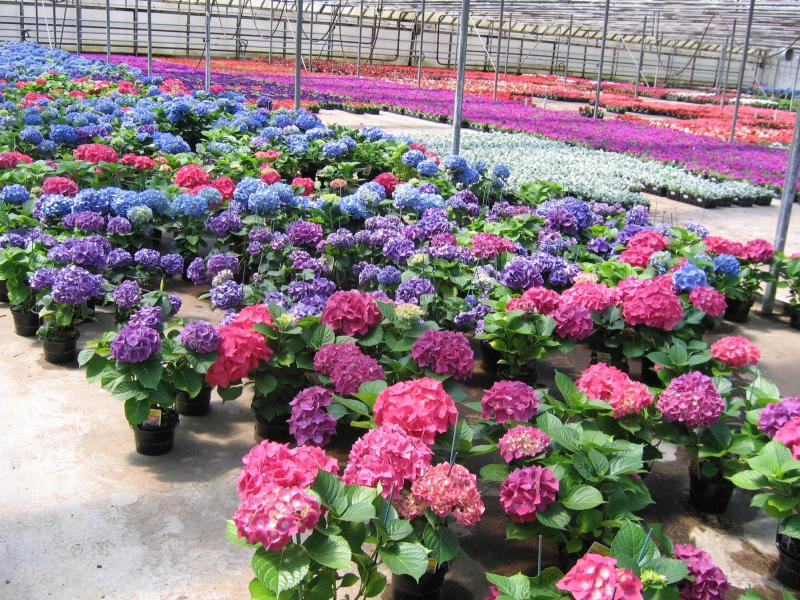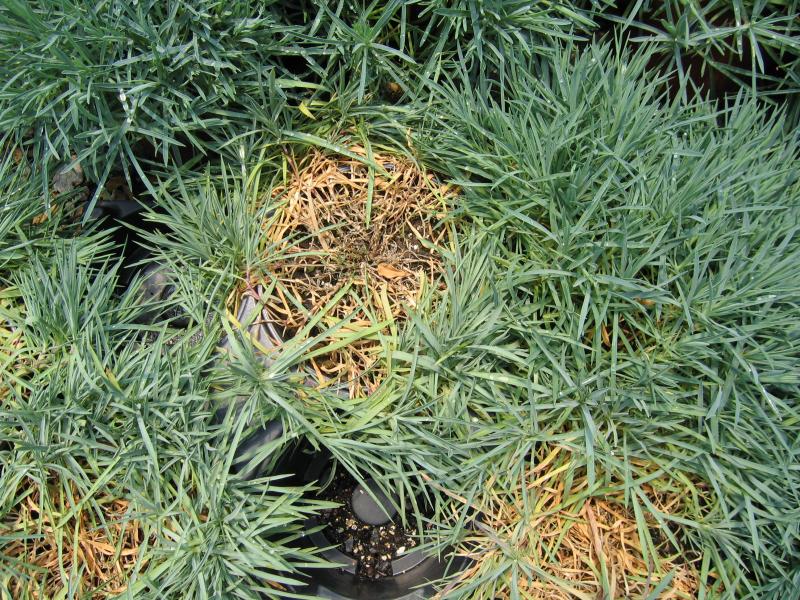Herbaceous Perennials: What are Your Worst Enemies?

The most common diseases on any group of ornamentals is based on a number of factors including how the plants are propagated, where they are utilized (landscape, indoors, bouquets) and what conditions the plants require for best growth. Herbaceous perennials in the landscape can differ based on where they are being grown but often we see many of the same plants from Quebec to Florida.
The characteristics of herbaceous perennials that affect their diseases are:
-Propagated often through divisions or cuttings
-Long-lived in the landscape
-Many environments
-Dormancy
-Rarely grown in mass (monoculture is uncommon)
The most common problems of herbaceous perennials include : foliar nematode, downy mildew, powdery mildew and rust, Fusarium or Rhizoctonia crown rot, viruses from tobacco rattle virus to Hosta virus X (HoVX).
Foliar Nematodes
Foliar nematodes (Aphelenchoides spp.) can be common on many herbaceous ornamentals since they are grown tightly in a landscape and often watered overhead or exposed to rainfall. This makes movement of the nematodes very easy though splashing. The fact that the plants are often propagated by division also makes the foliar nematode infestation move right a long with the new perennial. Common hosts are Japanese anemone, bergenia, hosta, phlox, echinacea and ferns. Foliar nematode is not restricted to specific genera of herbaceous perennial but rather attacks many, many different herbaceous perennials.
Symptoms appear first on older leaves and you can sometimes slow down progress by hand picking the affected leaves. They can be confused with bacterial leaf spots and downy mildew on some plants since they may all develop necrotic lesions that are confined between leaf veins. Be sure to destroy infected plants (or at least leaves) or remove completely from the production or landscape area (do not put into a compost pile). If you irrigate at the ground level you can reduce nematode spread by splashing water. There are no nematicides labeled for foliar nematodes that have been proven consistently effective, although a few products say they will work.
Obligate Parasites
Fungi that are obligate parasites cannot survive or reproduce without a susceptible plant to infect. They include rust, downy mildew and powdery mildew, and all are commonly found in herbaceous perennials from production into their landscape use. This is due to a variety of factors including growth outdoors (nobody can control the weather) and long-lasting spores on dry leaves (rusts) that are left in the landscape year-round even when the plant is dormant. They can be very host specific (rust and downy mildew) and like the foliar nematode are worse when plants are sprinkler irrigated or exposed to rainfall. Heuchera, veronica, sunflower, mum, hypericum, iris and daylily can be very commonly affected by rust throughout the United States.
Rust diseases thrive in warm, moist weather and can move long distances via air movement. Avoid overhead irrigation, increase plant spacing and use resistant cultivars whenever possible. Most rust diseases are specific to a genus or closely related plants. If rust is a problem you can consider using another type of perennial in its place. For instance daylily rust does not affect iris and iris rust does not affect daylilies. In production, rust diseases can be prevented through judicious use of fungicides.
Downy mildew is also common on a wide variety of herbaceous perennials. Removing infected plants from propagation, production and landscape areas can greatly reduce this disease. A few downy mildew fungi are known to produce oospores that can live in crop debris or soil over the winter, infecting new leaves as they emerge in the spring. Perennials that are attacked by downy mildew fungi (usually specific to a single plant type or closely related plants) include : buddleia, lamium, phlox, salvia, hellebore, aster, coreopsis and veronica.
Downy mildews are not just cool weather diseases anymore but are generally worst between 58-72° F or when the relative humidity is 95 percent. Air circulation around plants can reduce the relative humidity and thus disease pressure. The tight nature of perennial plantings makes high humidity and overhead irrigation a constant and thus downy mildew and rust may be common. If possible, avoid overhead irrigation or irrigate when the plant leaves will dry most quickly never irrigate at night if you have a choice.
Powdery mildew diseases are probably the most commonly recognized and accurately diagnosed plant diseases. Some of the fungi that cause powdery mildew are narrow in their host range while others are very broad (like the one attacking composite flowers). Powdery mildews spread via air currents and wet leaves actually discourage their development. Using resistant cultivars (trial and error can tell you which ones) and reducing relative humidity through plant spacing and timing irrigation to allow the fastest leaf drying will help reduce disease. In production, powdery mildew can be controlled by a wide variety of products including those that are considered biopesticides.
 Fusarium crown rot on dianthus in production.
Fusarium crown rot on dianthus in production.
Crown Rots
Rhizoctonia causes most of the crown rot disease in the landscape while Fusarium crown rots are more common in propagation and production. Rhizoctonia solani causes root rot, damping-off, crown rot, stem rot and aerial blight (with leaf spots). The plants most often affected are: asclepias, centranthus, dianthus, erysimum, euphorbia, farfugium, gaillardia, gypsophila, helianthus, iberis, kniphofia, leucanthemum, liatris, lilium, limonium, lobelia, lupinus, lychnis, papaver, pentas, rosamarinus, salvia, sedum, teucrium and viola. Plants know to be attacked by Fusarium crown rot include alstroemeria, bulb crops (caladium, crocosmia, gladiolus, iris), chrysanthemum, Clematis, dianthus, erysimum, hosta and phlox.
The fungi are opportunistic and both survive well in the soil as a saprophyte without a susceptible plant host. They are also very broad in its host range with no real specialization shown. That means that Rhizoctonia crown rot can kill one perennial and proceed to kill many more that might be used as a replacement in the same spot. It is spread via infected plants and movement of contaminated soil. Removing and replacing the soil around a plant killed by Rhizoctonia crown rot may be the most effective means of combating this disease.
Herbaceous perennials suffer from crown rot mainly in propagation and in the landscape. In propagation, condition very wet and crowded plants that are easily stressed as they attempt to root. Fusarium especially occurs on stressed plants. In the landscape, stress can also be an issue and irrigating a mixed planting of herbaceous perennials almost always means that not all plants receive the optimal irrigation. And like many of the other problems of herbaceous perennials, overhead irrigation and rainfall make ideal conditions for crown rot spread and occurrence.
 Unidentified virus in agapanthus.
Unidentified virus in agapanthus.
Viruses
Tobacco Rattle Virus is one of the most common virus diseases on herbaceous perennials. It is found on: anemone, aster, dicentra, epimedium, gladiolus, heuchera, hosta, limonium, narcissus, paeonia, phlox, thalictrum and tulipa. This virus is primarily spread via soil-borne nematodes Trichodorus and Paratrichodorus. It has rarely been seed-borne on some crops like tomato.
HoVX symptoms include mosaic, mottling, interveinal chlorosis and leaf desiccation and occurs only on hostas. Symptoms vary on different cultivars and at different times.
The huge range of herbaceous perennials has led to many new viruses as we continue to indroduce new genera, species and cultivars without adequate evaluation for internal viruses while rarely showing symptoms. In addition, in some cases insects spread viruses; Cucumber Mosaic Virus (CMV) is moved by aphids and tospoviruses (INSV and TSWV) are moved by thrips. Controlling these pests outdoors is an especially frustrating experience. Some viruses die quickly outside the plant (INSV and CMV) while others last a long time (Tobacco Mosaic Virus [TMV]). TMV and HoVX are most transferred with infected vegetative propagative material. Always avoid buying plants with virus symptoms (even ones with portions that look OK) and never propagate from them. There is no cure once a plant is infected with a virus.
So remember, not all plants get all diseases. Knowing what types of problems might occur on herbaceous perennials can keep you from over-using fungicides and wasting money on treatments that aren’t necessary.


 Video Library
Video Library 




















